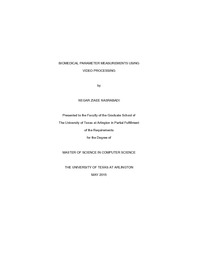| dc.description.abstract | For quite some time, patients’ cardiovascular parameters have been measured by sensors connected to their body. One way of measuring these parameters is pulse oximetry by using an optical technique. It uses a photodetector to detect light absorption changes of red and infrared light. These two types of light serve as two sources of illumination. These current types of methods for monitoring parameters are often viewed as uncomfortable by the patient, and therefore are not desirable for frequent and long periods of monitoring. Furthermore, these methods can potentially produce a psychologically influenced bias from the patient because the patient is physically involved with the monitoring. As a result, there is a desire for a more patient friendly method for measuring cardiovascular parameters. Recent research has shown that the cardiovascular parameters can be measured by using a camera’s digital video of a person’s face and daylight as an illumination source. This research opens a vast opportunity for remote, low cost, and convenient monitoring of cardiovascular parameters. Using the optical technique, these novel methods extract the cardiovascular signal using light reflected from the face, and it ultimately allows important data about the cardiovascular parameters to be extracted from a distance. These parameters include the blood flow signal, heart rate, blood oxygen, and blood pressure. Furthermore, these methods allow frequent and remote monitoring of a patient in a given environment while also guaranteeing that the parameters obtained are free from patient bias. As a result, this method can routinely measure the patient’s parameters during long periods of time which is desirable.This line of research has been extended in this research by designing a system to measure the changes of blood related health conditions more conveniently. The low cost system analyzes the whole face and processes the reflected light signal of a local area on the face. In this study we use visible and infrared light as a source of illumination to measure the parameters using different light spectrum wavelengths which include red, green, and infrared light.The method investigated here is advantageous because the patients’ comfort level is not sacrificed for accurate monitoring, and because it allows for routine and long term monitoring. Routine monitoring of the cardiovascular parameters’ changes is desired because the parameters that are influenced by illness are frequently tracked. Ultimately, it allows the monitoring and tracking of the illness’ progression and thus supports a more accurate diagnosis than traditional techniques. | en_US |

